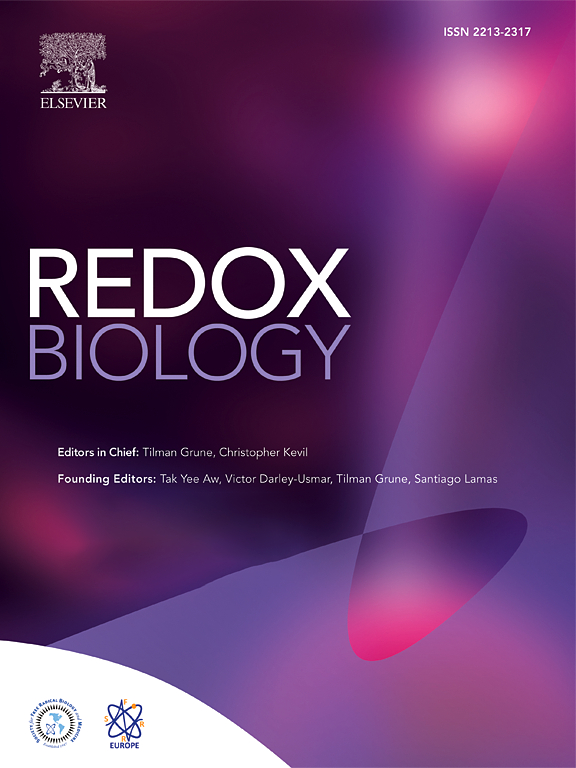Hippo/ACSL4轴在败血症铁蛋白沉积诱导的周细胞丢失和血管功能障碍中的作用
IF 10.7
1区 生物学
Q1 BIOCHEMISTRY & MOLECULAR BIOLOGY
引用次数: 0
摘要
败血症是一种危重病症,其特点是对感染的全身炎症反应,通常会导致严重的血管功能障碍和高死亡率。败血症血管功能障碍的特征之一是血管通透性增加和周细胞丧失,而周细胞对维持血管完整性至关重要。尽管脓毒症导致的周细胞丢失非常重要,但对造成细胞死亡的主要类型和潜在的分子机制仍不完全清楚。本研究旨在通过重点研究铁凋亡(一种程序性细胞死亡形式)及其通过 Hippo/ACSL4 轴的调控来阐明这些机制。我们的研究证实,脓毒症患者体内的包膜细胞明显减少。通过先进的单细胞分析和蛋白质组学,我们发现铁凋亡是区分败血症样本和假样本的关键细胞死亡类型。进一步的代谢组学分析表明,乙酰辅酶长链家族成员4(ACSL4)在脓毒症期间周细胞的铁凋亡中起着关键作用。体外实验表明,下调 ACSL4 能有效降低脂多糖(LPS)诱导的脂质过氧化反应,恢复周细胞的活力,并改善内皮通透性。用特异性 ACSL4 基因敲除小鼠进行的体内研究表明,脓毒症诱导后,周细胞丢失明显减少,血管屏障功能增强。为了将这些发现转化为潜在的治疗策略,我们开发了包裹 ACSL4 shRNA 腺病毒的周细胞靶向脂质体。这些脂质体成功恢复了肺血管屏障功能,并显著减少了脓毒症条件下的周细胞损失。这项研究的结果强调了ACSL4在介导周细胞铁突变中的关键作用,并突出了靶向ACSL4以缓解脓毒症血管功能障碍的治疗潜力。本文章由计算机程序翻译,如有差异,请以英文原文为准。
Role of Hippo/ACSL4 axis in ferroptosis-induced pericyte loss and vascular dysfunction in sepsis
Sepsis is a critical condition characterized by a systemic inflammatory response to infection, often leading to severe vascular dysfunction and high mortality. One of the hallmarks of vascular dysfunction in sepsis is increased vascular permeability and the loss of pericytes, which are essential for maintaining vascular integrity. Despite the significance of pericyte loss in sepsis, the primary type of cell death responsible and the underlying molecular mechanisms remain incompletely understood. This study aims to elucidate these mechanisms by focusing on ferroptosis, a form of programmed cell death, and its regulation through the Hippo/ACSL4 axis. Our research confirmed significant pericyte loss in patients with sepsis. Through advanced single-cell analysis and proteomics, ferroptosis was identified as a key differentiating cell death type between sepsis and sham samples. Further metabolomics analysis revealed that Acyl-CoA Synthetase Long-Chain Family Member 4 (ACSL4) plays a pivotal role in the ferroptosis of pericytes during sepsis. In vitro experiments demonstrated that downregulation of ACSL4 effectively reduced lipopolysaccharide (LPS)-induced lipid peroxidation, restored pericyte viability, and improved endothelial permeability. In vivo studies with pericyte-specific ACSL4 knockout mice showed a marked decrease in pericyte loss and enhanced vascular barrier function following sepsis induction. To translate these findings into potential therapeutic strategies, we developed pericyte-targeting liposomes encapsulating ACSL4 shRNA adenovirus. These liposomes successfully restored pulmonary vascular barrier function and significantly reduced pericyte loss in septic conditions. The results of this study underscore the crucial role of ACSL4 in mediating ferroptosis in pericytes and highlight the therapeutic potential of targeting ACSL4 to mitigate vascular dysfunction in sepsis.
求助全文
通过发布文献求助,成功后即可免费获取论文全文。
去求助
来源期刊

Redox Biology
BIOCHEMISTRY & MOLECULAR BIOLOGY-
CiteScore
19.90
自引率
3.50%
发文量
318
审稿时长
25 days
期刊介绍:
Redox Biology is the official journal of the Society for Redox Biology and Medicine and the Society for Free Radical Research-Europe. It is also affiliated with the International Society for Free Radical Research (SFRRI). This journal serves as a platform for publishing pioneering research, innovative methods, and comprehensive review articles in the field of redox biology, encompassing both health and disease.
Redox Biology welcomes various forms of contributions, including research articles (short or full communications), methods, mini-reviews, and commentaries. Through its diverse range of published content, Redox Biology aims to foster advancements and insights in the understanding of redox biology and its implications.
 求助内容:
求助内容: 应助结果提醒方式:
应助结果提醒方式:


